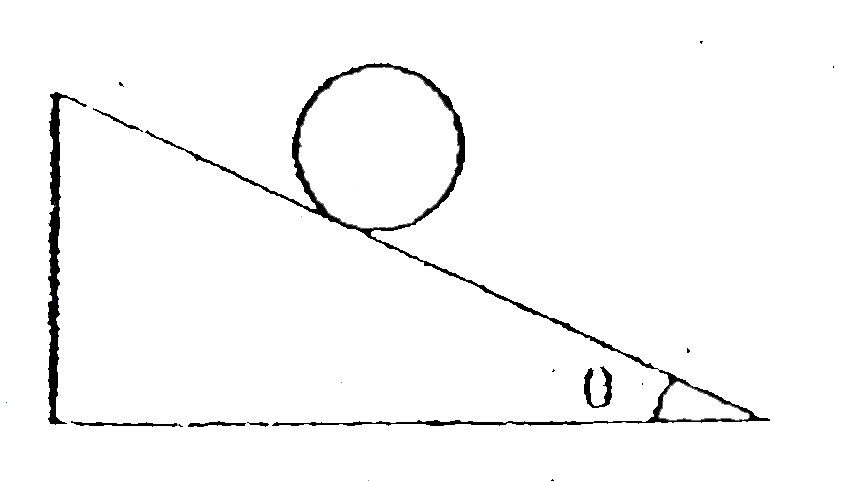A solid cylinder is placed on the end of an inclined plane. It is found that the plane can be tipped at an angle θ before the cylinder starts to slide. When the cylinder turns on its sides and is allowed to roll, it is found that the steepest angle at which the cylinder performs pure rolling is ϕ. The ratio tanϕ/tanθ is
3
13
1
12
The correct Answer is:A
To solve the problem, we need to analyze the forces and torques acting on the solid cylinder when it is placed on an inclined plane. We will derive the relationship between the angles θ and ϕ and find the ratio tanϕtanθ.
1. Understanding the Forces:
When the inclined plane is at an angle θ, the gravitational force acting on the cylinder can be resolved into two components: one parallel to the incline mgsinθ and one perpendicular to the incline mgcosθ.
2. Condition for Sliding:
The cylinder will start to slide when the component of gravitational force parallel to the incline exceeds the static friction force. The maximum static friction force is given by fs=μsN, where N=mgcosθ is the normal force and μs is the coefficient of static friction. Thus, we have:
mgsinθ=μsmgcosθ
Simplifying, we get:
tanθ=μs
3. Condition for Pure Rolling:
When the cylinder rolls without slipping, the condition for pure rolling is that the frictional force must provide the necessary torque for rolling. The torque τ about the center of mass is given by:
τ=fr⋅r
where fr is the frictional force and r is the radius of the cylinder. The moment of inertia I of a solid cylinder about its center is 12mr2.
4. Using Newton's Second Law for Rotation:
The angular acceleration α is related to the linear acceleration a by:
a=rα
Therefore, we can write:
τ=Iα⟹fr⋅r=12mr2⋅ar⟹fr=12ma
5. Setting Up the Equation for Pure Rolling:
The net force acting on the cylinder when it is rolling is:
mgsinϕ−fr=ma
Substituting fr=12ma:
mgsinϕ−12ma=ma⟹mgsinϕ=32ma
Thus, we have:
a=23gsinϕ
6. Relating the Angles:
From the earlier conditions, we have:
tanϕ=ag=23sinϕ
And from the sliding condition:
tanθ=μs
7. Finding the Ratio:
Now, we relate the two angles:
tanϕtanθ=23sinϕμs
Given that tanθ=μs, we can express the ratio as:
tanϕtanθ=23⋅sinϕμs
8. Final Ratio:
After substituting and simplifying, we find:
tanϕtanθ=27
Conclusion:
Thus, the ratio tanϕtanθ is 27.
When the inclined plane is at an angle θ, the gravitational force acting on the cylinder can be resolved into two components: one parallel to the incline mgsinθ and one perpendicular to the incline mgcosθ.
The cylinder will start to slide when the component of gravitational force parallel to the incline exceeds the static friction force. The maximum static friction force is given by fs=μsN, where N=mgcosθ is the normal force and μs is the coefficient of static friction. Thus, we have:
mgsinθ=μsmgcosθ
Simplifying, we get:
tanθ=μs
When the cylinder rolls without slipping, the condition for pure rolling is that the frictional force must provide the necessary torque for rolling. The torque τ about the center of mass is given by:
τ=fr⋅r
where fr is the frictional force and r is the radius of the cylinder. The moment of inertia I of a solid cylinder about its center is 12mr2.
The angular acceleration α is related to the linear acceleration a by:
a=rα
Therefore, we can write:
τ=Iα⟹fr⋅r=12mr2⋅ar⟹fr=12ma
The net force acting on the cylinder when it is rolling is:
mgsinϕ−fr=ma
Substituting fr=12ma:
mgsinϕ−12ma=ma⟹mgsinϕ=32ma
Thus, we have:
a=23gsinϕ
From the earlier conditions, we have:
tanϕ=ag=23sinϕ
And from the sliding condition:
tanθ=μs
Now, we relate the two angles:
tanϕtanθ=23sinϕμs
Given that tanθ=μs, we can express the ratio as:
tanϕtanθ=23⋅sinϕμs
After substituting and simplifying, we find:
tanϕtanθ=27
Thus, the ratio tanϕtanθ is 27.
Topper's Solved these Questions
- BOOK - CENGAGE PHYSICS ENGLISHCHAPTER - RIGID BODY DYNAMICS 2EXERCISE - Multiple Correct26videos
RIGID BODY DYNAMICS 2
- BOOK - CENGAGE PHYSICS ENGLISHCHAPTER - RIGID BODY DYNAMICS 2EXERCISE - Linked Comprehension71videos
RIGID BODY DYNAMICS 2
- BOOK - CENGAGE PHYSICS ENGLISHCHAPTER - RIGID BODY DYNAMICS 2EXERCISE - Subjective19videos
RIGID BODY DYNAMICS 2
- BOOK - CENGAGE PHYSICS ENGLISHCHAPTER - RIGID BODY DYNAMICS 1EXERCISE - Integer11videos
RIGID BODY DYNAMICS 1
- BOOK - CENGAGE PHYSICS ENGLISHCHAPTER - SOUND WAVES AND DOPPLER EFFECTEXERCISE - Integer16videos
SOUND WAVES AND DOPPLER EFFECT
Similar Questions
Knowledge Check
- Question 1 - Select One
A solid cylinder rolls up an inclined plane of inclination θ with an initial velocity v. How far does the cylinder go up the plane ?
A3v22gsinθBv24gsinθC3v2gsinθD3v24gsinθ
A solid cylinder is rolling down the inclined plane without slipping. Which of the following is correct?
 View Solution
View SolutionA solid cylinder of mass M and radius R rolls without slipping down an inclined plane of length L and height h. What is the speed of its center of mass when the cylinder reaches its bottom
View SolutionA solid cylinder is rolling down on an inclined plane of angle θ. The minimum value of the coefficient of friction between the plane and the cylinder to allow pure rolling
View SolutionA cylinder is rolling without slipping on an inclined plane. Show that to prevent slipping the condition is μs≥13tanθ.
View SolutionA hollow cylinder and a solid cylinder are rolling without slipping down an inclined plane, then which of these reaches earlier ?
View SolutionA solid cylinder of mass M and radius R rolls from rest down a plane inclined at an angle θ to the horizontal. The velocity of the centre of mass of the cylinder after it has rolled down a distance d is :
View SolutionA cylinder is released from rest from the top of an incline of inclination θ and length 'L'. If the cylinder rolls without slipping. What will be its speed when it reaches the bottom?
View Solution

